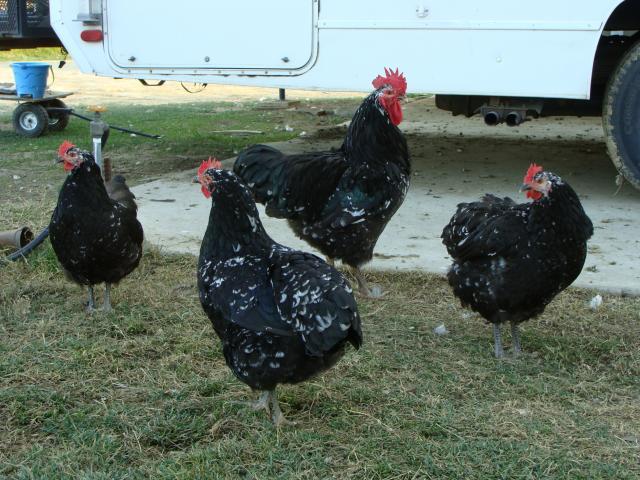Ok all you experts out here (Walt, Bob, Chris, Jamie, others...) I need some help/advise
First, let me set the stage here. I have Heritage Columbian Rock and Barred Rock large fowl. My "passion" is going to be with the Columbian Rocks. I currently have space in 3 separate coops with attached outside runs to "comfortably house" about 40 grown birds and have 2 smaller coops with runs for "grow up" pens. I have no interest (at least not at this point, LOL) in showing birds, I just want to raise them to be improved each year, closer and closer to the standard in the SOP, and for my enjoyment.
Jamie Duckworth was kind enough to send me a LOT of old poultry reading materials including a copy of "start where you are with what you have".....
So.....I have been doing as much reading and learning as I can and I am planning for next year. I think I have a grasp on the concept of line-breeding and how it should be done. Looks like I will have:
In Columbians
2 cockerels and 6 pullets
In BRs
2 cockerels and 4 pullets
So, let's say this next Spring I hatch off 100 chicks from the Columbians and I get (using the rule of 10's) 10 better looking young birds to keep. Let's say its the best 8 pullets and best 2 cockerels. At that point I become "lost" as to what you do. I understand that you want to breed the daughters back to the fathers and sons back to the mothers...BUT,
Do I:
1. Keep only the hens that produced the best chicks (the ones I decided to keep) and sell off the others?
2. Do I keep the original sires AND the 2 new cockerels?
3. Sell off a rooster if he did not throw one of the better cockerels?
I guess I'm looking for some advise or plan for after "breeding year 1", how do you decide what to keep of your original stock? At what point do you begin replacing aging hens and/or roosters?
I know this is a little long and I'm sorry for that.....just trying to get a handle on what I should be planning for in 2011.
Thanks!
Scott
First, let me set the stage here. I have Heritage Columbian Rock and Barred Rock large fowl. My "passion" is going to be with the Columbian Rocks. I currently have space in 3 separate coops with attached outside runs to "comfortably house" about 40 grown birds and have 2 smaller coops with runs for "grow up" pens. I have no interest (at least not at this point, LOL) in showing birds, I just want to raise them to be improved each year, closer and closer to the standard in the SOP, and for my enjoyment.
Jamie Duckworth was kind enough to send me a LOT of old poultry reading materials including a copy of "start where you are with what you have".....
So.....I have been doing as much reading and learning as I can and I am planning for next year. I think I have a grasp on the concept of line-breeding and how it should be done. Looks like I will have:
In Columbians
2 cockerels and 6 pullets
In BRs
2 cockerels and 4 pullets
So, let's say this next Spring I hatch off 100 chicks from the Columbians and I get (using the rule of 10's) 10 better looking young birds to keep. Let's say its the best 8 pullets and best 2 cockerels. At that point I become "lost" as to what you do. I understand that you want to breed the daughters back to the fathers and sons back to the mothers...BUT,
Do I:
1. Keep only the hens that produced the best chicks (the ones I decided to keep) and sell off the others?
2. Do I keep the original sires AND the 2 new cockerels?
3. Sell off a rooster if he did not throw one of the better cockerels?
I guess I'm looking for some advise or plan for after "breeding year 1", how do you decide what to keep of your original stock? At what point do you begin replacing aging hens and/or roosters?
I know this is a little long and I'm sorry for that.....just trying to get a handle on what I should be planning for in 2011.
Thanks!
Scott







